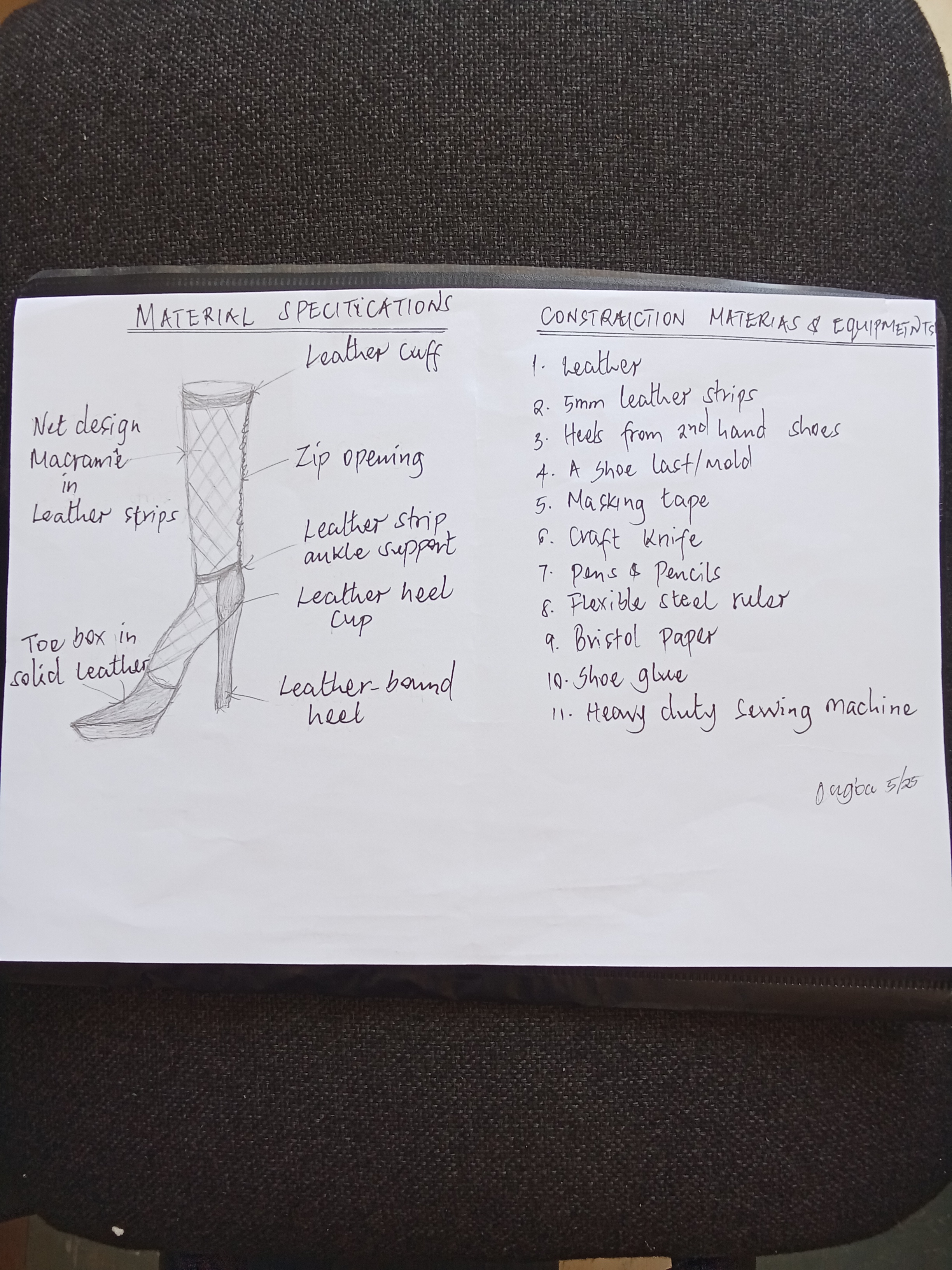SAVANNA BOOTS DESIGN PROJECT
Category: Footwear
SAVANNA BOOTS DESIGN PROJECT Project Summary The Savanna boot is designed for the hot and dry climate that covers a large percentage of the African continent. It uses mainly cow hide leather, a material that is locally available and has traditionally been used for production of dress items in Africa. The design also uses heels obtained from the waste of secondhand shoes available in most African countries. It is assembled primarily using macramé, a technique that owes its origin in Africa. The true lovers knot is used to create the net pattern macramé piece that covers the lower leg and a section of the upper parts of the boot. Savanna Boots concept Macramé, which essentially comprises a variety of knotting techniques, holds symbolic meanings in most African cultures relating to unity, protection, and cultural identity. The true lovers knot used in this project would traditionally be used in Africa to signify an unbreakable bond. Among Abagusii community of Kenya for instance, it could be used to create wedding bands known as Ebitinge, made by an intricate knotting together of metal rings (Chintere) and leather strips (chinuga). These wedding bands were won at the ankles of both legs by married women. The bands not only identified the status of the women as married but also created an unbreakable covenant that bound the women to their marriages and marital homes, ensuring zero divorce rates in the community. Like ebitinge, the Savanna boot design is both a symbol of African identity as well as an African patriotic statement; an unbreakable bond of the African continent. The boots signify the need for Africa to unite in the search for sustainable solutions particularly to climate change among other regional and global challenges. Savanna Boots unique selling point Besides the elegance of a boot, the Savanna boot design offers an airy comfort that is difficult to achieve with the regular closed up boots. The net design ensures free circulation of air on the lower legs and the upper part of the foot which keeps the legs and feet from getting hot especially in the hot and dry climate. This design also enables the boot to be collapsible, making it easy to package both for storage and frequent movement; a common practice in this region of the world. Design Inspiration besides the knotting practices common in most African communities, the Savanna boot is also inspired by the sandals worn by the pastoral communities in Kenya. These communities are known for their love for livestock and their nomadic lifestyle, dictated by the need to search for pasture and water for their livestock. For this reason, members of these communities traverse the country on a yearly cycle. Due to this frequent movement, they carry very few possessions comprising the basic necessities. One of these absolute necessities are sturdy sandals traditionally made of study animal hide such as camel hide or, in recent times, old motor vehicle tires. Storyboard Figure 1: Traditional footwear and knotting practices in Kenya (See figure in my assets) Figure 2: Net design Macramé using true lovers knot (See figure in my assets) Why Savanna Boot? Shoes are an important component of dress particularly in areas with climatic conditions considered harsh for human life. The hot and dry conditions in most parts of Africa pose a challenge in the design of footwear that will at once protect the feet from the hot and sometimes rocky terrain, and provide the elegance necessary for certain social events. In most cases, people have to contend with the heat experienced in closed shoes just to dress for the occasion. This is not only uncomfortable but also exposes one to foot disorders such as fungal infections that are caused by lack of aeration. The Savanna boot design is created to offer a solution to this. The macramé pattern that covers most part of the shoe is not only airy but also strong enough to withstand the wear and tear of the terrain. The durability of leather works well for the slow fashion which is both the economically viable fashion option as well as the option that matches the minimalist lifestyle of choice for majority of the people in this region. Livestock is the main source of income and food in the hot and dry regions of Africa. For this reason, leather is readily available as a byproduct. However, due to lack of capacity for value addition on it, the resource is disposed as waste thereby causing a waste disposal and sanitation challenge, leading to the risk of communicable diseases. The Savanna boot will harness this resource to create valuable products while at the same time providing a solution to the waste disposal challenge, and cubing disease preference in the region. Kenya is among the largest consumers of secondhand clothing from fast fashion. The vast waste from this market poses a huge waste disposal challenge for the country. By recycling heels from old secondhand shoes, this project will reduce the amount of waste generated from secondhand shoes; turning the lemons from the secondhand market in to lemonade for Kenyans. Technical Specifications (See figure in my assets) Construction Materials and Techniques The patterns for the shoe design will be developed using the lasting method. The following materials and equipment will be used in the whole production process 1. Cow hide Leather 2. 5mm leather strips from waste cow hide leather 3. Wedge, platform or cork high heels from second hand shoes 4. A shoe last/mold 5. A roll of 1/2-inch-wide masking tape 6. Craft knife 7. Pens and pencils. 8. Flexible steel ruler. 9. manila paper 10. shoe glue 11. 10 inch Clauss shears 12. Precision knife 13. Rotary strap cutter 14. Tack nails 15. Hammer 16. Hole pucnh 17. Leather shaping machine (Toe shaping and Back part molding) 18. shoe heel nailing machine 19. Waxed polyester or bonded nylon sewing thread 20. Assorted sewing machine needles 21. Heavy duty Sewing machine 22. Polypropylene cutting table/board Construction Technique Procedure for the upper • Using a shoe last/mold that matches the design idea, tape (cover) the last with masking tape • Dividing the shoe last in half laterally, draw in the components of the shoe on one half of the shoe last • Cut out the components separately and pull them off the last to form the pattern pieces for the upper • Cut out these patterns on fold in manila paper or waste leather and try them out on the last to check the fit and make any adjustments • Once satisfied with the fit, cut the patterns out on leather Procedure for the shaft • With the leather strips, create a macramé piece in net design using the true lovers knot to the measurements of the pattern piece for the shaft and upper • Join the pattern pieces for the shaft and the upper as per the design and machine stitch • shape the toe and mold the back part using leather shaping machines • Attach the heels from second hand shoes using shoe glue and secure it using a shoe heel nailing machine
Download PDF 1

 Copy URL
Copy URL
 Login to Like
Login to Like 